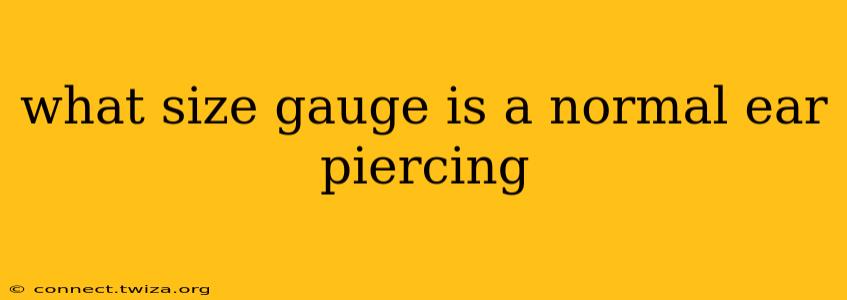The "normal" size for an ear piercing is a bit subjective, as it depends on several factors, including the type of piercing, personal preference, and the piercer's recommendations. However, we can define a common range and explore the nuances to help you understand what to expect.
Generally, the most common gauge for initial ear piercings (lobe piercings) is 20 gauge (0.8mm). This size is considered ideal for several reasons: it's thin enough to minimize trauma during the piercing process, allows for comfortable healing, and is wide enough to accommodate standard earrings. You'll often find that most starter earrings are designed for this gauge.
However, let's address some common questions surrounding ear piercing gauge sizes:
What Gauge is Best for Ear Piercings?
The best gauge for you depends on your specific needs and preferences. While 20 gauge is the standard for initial lobe piercings, other factors influence this choice:
-
Piercing Location: Cartilage piercings (like helix, tragus, or daith) often start with a slightly thicker gauge, such as 16 gauge (1.2mm) or even 14 gauge (1.6mm), due to the increased density of cartilage. These thicker gauges can help reduce the risk of the piercing tearing.
-
Healing Process: Thicker gauges may sometimes heal more slowly. Conversely, thinner gauges might be more susceptible to damage or infection during the healing process. Your piercer can advise you on the best gauge for your specific anatomy and chosen piercing location.
-
Personal Preference: Once your piercing has fully healed, you can downsize or change to different gauge earrings to suit your personal style.
What Size Gauge is Too Small for an Ear Piercing?
Gauges smaller than 20 gauge (like 22g or 24g) are generally not recommended for initial piercings, especially in the earlobe. These tiny gauges are more fragile and increase the risk of the piercing closing up quickly or becoming infected during healing. They are best reserved for those who already have established, healed piercings.
What Gauge is a Standard Earring?
While the starting gauge is typically 20g, "standard" earring gauges vary widely. Once healed, you can wear earrings in a range of gauges, from 18g to even larger sizes depending on your preference and the style of earring. Many earrings are available in 20g, making it easy to maintain the initial piercing size.
Can I Change the Gauge of My Ear Piercing Myself?
No. Changing the gauge of your ear piercing yourself is strongly discouraged. It’s a procedure best left to a professional piercer to minimize the risk of infection, scarring, and improper placement. Improperly downsizing or upsizing can significantly damage the piercing and surrounding tissue.
How Do I Know What Gauge My Ear Piercing Is?
If you're unsure of your piercing gauge, you can:
- Check your original earrings: Most starter earrings have the gauge stamped on them (often a small number next to the post).
- Ask your piercer: Your piercer will have a record of the gauge used for your piercing.
- Measure your earrings: While not perfectly precise, you can measure the diameter of the post to get an approximate gauge.
In conclusion, while a 20-gauge piercing is considered the standard for initial earlobe piercings, the appropriate gauge depends greatly on individual factors. Always consult a reputable piercer for professional advice tailored to your needs. They will help you choose the right gauge and provide the best care instructions to ensure a smooth and successful piercing experience.
